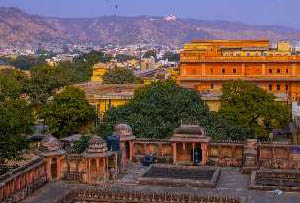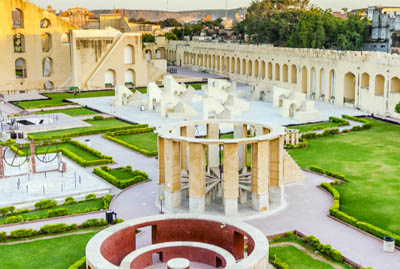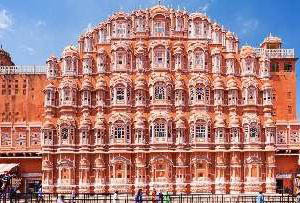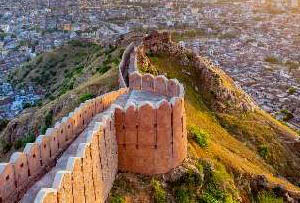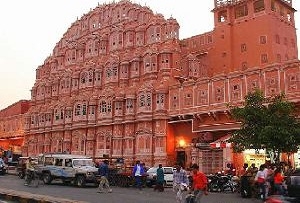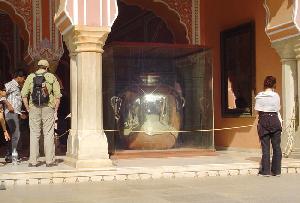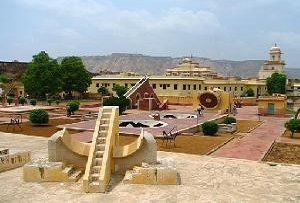Jaipur, the Pink City, where history meets elegance through its iconic palaces and bustling bazaars. With 34 years of expertise, Indian Holiday brings you the best-customised tour packages and trusted local support, ensuring a journey as royal as Rajasthan itself.
Still, wondering why Indian Holiday is your best choice? Read this: Your Complete Guide to Stress-Free Group Travel with Indian Holiday How to Plan a Stress-Free Family Vacation with Indian Holiday
Amber Fort History
Amber Fort was founded by Raja Man Singh in 1592 AD and later expanded and renovated by Raja Jai Singh I. It was initially built as themain residence of the Rajput Maharajas and their families. Subsequent rulers expanded and fortified it. Over the years, it has undergone several renovations, with some old structures replaced or renovated. Today, the fort stands strong as a symbol of Rajput art, power, and culture, inviting tourists worldwide and ranking among India’s finest forts.
Jaipur offers more than just stunning palaces and forts which you can experience with our guide to the most exciting things to do and see in Jaipur.
Amber Fort Architecture
Amber Fort has ancient Indian architecture that blends Hindu and Mughal styles. Built on a hill for strategic defence, the fort features pale yellow-pink sandstone with white marble and cobbled pathways. The exterior showcases beautiful sandstone carvings, while the interior has four courtyards with various attractions, including buildings, gates, and temples.
Explore 15 Days Rajasthan Goa Mumbai Tour Package
Amber Fort Layout
The fort is divided into four courtyards, each with a gate and attractions. Various pathways connect these courtyards and showcase excellent craftwork.
First Courtyard
The first courtyard has an open area for victory parades, temples, and rooms for soldiers. It also has structures that were very significant to the royal family.
Suraj Pol (Sun Gate): This eastern-facing gate, the main entrance to the fort, is named for its alignment with the sunrise, symbolising a new day and new beginnings.
Jaleb Chowk: This is the first main courtyard used for military parades and public gatherings. Royal women watched the army parade from latticed windows.
Shila Devi Temple: This temple took 10 years to complete, and its black goddess idol is carved from a sea-retrieved slab.
Suhag Mandir: This small temple, located above the Shila Devi Temple, was exclusively for royal women to offer prayers for the long lives of Maharajas.
Chand Pol (Moon Gate): Located opposite the Sun Gate, this gate serves as another entry point into the fort, enhancing its defensive capabilities.
Jaipur boasts a treasure trove of historical and cultural gems. Immerse yourself in the rich heritage of the city by exploring our guide to the must-see places to see in Jaipur.
Second Courtyard
Here, you can see the blend of Hindu, Mughal, and British architecture on walls and doors. Some ancient techniques for hot water and bathtubs are also there.
Diwaan-e-Aam: It is the venue where the king heard all the complaints and needs of the public. This area was built on a raised platform and has 27 arcades.
Third Courtyard
The third courtyard of the Amber Fort belonged to the Maharajas and the royal family.
Ganesh Pol (Ganesh Gate): The official entry into the Maharajas’ private palaces reflects a fantastic fusion of the Mughal and Rajput architecture. The wall paintings were made using natural vegetable colours. Small windows on this gate allow royal women to see courtyard activities.
Jai Mahal (Victory Palace): It is used for various royal functions and ceremonies and is known for its grandeur. Its walls, ceilings, and pillars are well-decorated with complex and fascinating designs.
Sheesh Mahal: The mirror work is so excellent that it can convert the light of a small candle into thousands of glowing stars. The hall’s interiors feature coloured glass and mirror mosaics, with ceilings and walls adorned with glass paintings and floral designs.
Palace of Man Singh I: The oldest part of the fort, the Palace of Man Singh I, is located south of the third courtyard. It was the principal palace on the royal property and had pillared pavilions (baradari), coloured tiles, and frescoes.
Mughal Garden: A star-shaped garden in front of the fort, known for its aesthetic design and historical significance.
Charbagh Garden: It has a central hexagonal pool and fountain that is known for its complex design, which has many different parts.
Tripolia Gate: It opens in three directions: Jaleb Chowk, another to the Man Singh Palace, and Zenana Deorhi.
Lion Gate: Also known as Sinh Pol, it was the main entrance for the royals. It was named for its strength and was adorned with wall paintings.
Need expert tips for your Jaipur vacation? Check our Jaipur tour Guide.
Fourth Courtyard
The fourth courtyard of the Amber Fort belonged to the royal women and king. It consists of numerous living rooms that the queens used as residences.
Zenana: There are 12 women’s quarters, designed to ensure privacy for the royal women, with interconnected rooms
Baradari Pavilion: The central pavilion was a gathering place surrounded by small rooms.
Explore our curated Jaipur Packages and discover the perfect itinerary to suit your interests and budget.
When to Visit Amer Fort
The best time to visit Amber Fort is between October and March, as these months bring a pleasant climate to the city. It is better to visit early in the morning to avoid the long queues and crowds.How to Reach
You can easily reach Amber Fort Jaipur by booking a taxi or a cab. From the Ajmeri Gate and MI road, so many buses go directly to Amber Fort. From here, the bus would take only 40 minutes to reach Amber Fort.
The fort is located at the hilltop, and you can reach it by:- Elephant rides are available from 7:30 am to 12:30 pm
- You can also book a Jeep
- You can also climb by taking a smaller route or taking old steps.
Amer Fort Timings
Amber fort visiting hours are from 8:00 a.m. to 7:00 p.m., so plan your visit accordingly. A complete tour of this fort will take approximately 3 to 4 hours.Amer Fort Ticket Price
You can purchase tickets from the counter in the Jaleb Chowk courtyard or online by visiting the official website of Rajasthan Tourism. Two types of tickets are available at this fort: General Tickets and Composite Tickets. Purchasing Composite tickets saves you time and money when exploring the monuments of Jaipur.
- General Ticket: Only Entry for Amber Fort
- Composite Ticket: It includes visits to Amber Fort, Nahargarh Fort, Hawa Mahal, Jantar Mantar Observatory, Albert Hall Museum, Sisodia Rani Garden, Isarlat, and Vidhyadhar Garden.
| Type of Tourists | General Ticket Price | Composite Ticket Price |
| Indians | 100 | 420 |
| Foreigners | 500 | 1100 |
The validity for the Composite ticket price is 2 days. You can also get free entry on special days, such as
- 30 March (Rajasthan Day)
- 18 April (World Heritage Day)
- 18 May (World Museum Day)
- 27 September (World Tourism Day)
Amer Fort Night and Sound Show
Enjoy the mesmerising night and sound show at the foot of Amer Fort. The show narrates local legends and folklore while celebrating folk music’s maestros. This surreal experience is a must-see during your visit. It is recommended to arrive 30 minutes early to secure a good seat. The seating is outdoors, with water surrounding you on three sides, enhancing the ambience.
Browse through our Jaipur Tour Packages from Delhi
Light and Sound Show Timings and Ticket Price
- October to February – 6:30 pm (English) – 07:30 pm (Hindi)
- March to April – 7:00 pm (English) – 08:00 pm (Hindi)
- May to September – 7:30 pm (English) – 8:30 pm (Hindi)
Places to Visit Near Amber Fort
There are plenty of tourist attractions and forts in Jaipur that you can add to your bucket list, such as;
- Hawa Mahal – 8.3 km (30 min)
- Jal Mahal – 5.4 km (15 min)
- Jantar Mantar -8.2 km (30 min)
- Jaigarh Fort – 7 km (25 min)
- Nahargarh Fort– 10 km (30 min)
Interesting Facts about Amber Fort
- A secret tunnel connects the Jaigarh Fort, and part of it has been restored and is also open to the public.
- The entire structure took more than 100 years.
- Sheesh Mahal’s Hall can be illuminated with just one candle, and many scenes from Bollywood movies have been filmed here.
- The fort served as the capital of Kacchwas Rajputs.
- This fort has a unique ancient technique for hot and cold water.
- Paintings on walls are made of natural colours of vegetables, flowers, and spices.
- Sheesh Mahal has a Magical Flower Design on the Wall that shows different figures whenever you place your hand on this painting, making it the artistic ingenuity of the era.
Check out Rajasthan Tour Packages, Pushkar Tour Packages, Udaipur Tour Packages, Chittorgarh Tour Packages, Jodhpur Tour Packages



